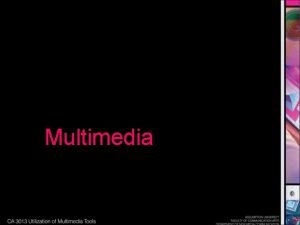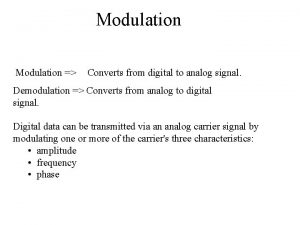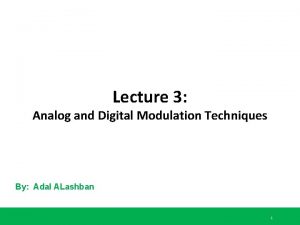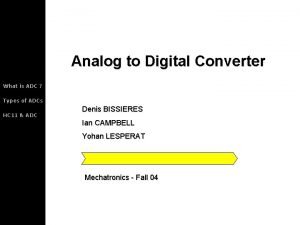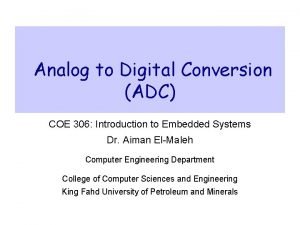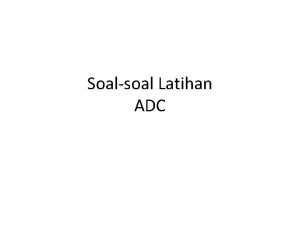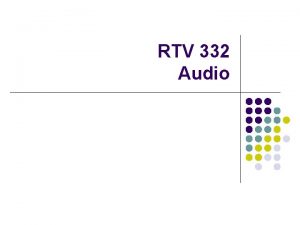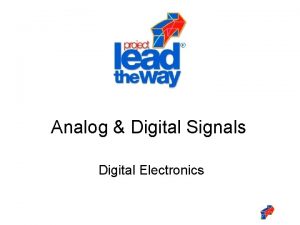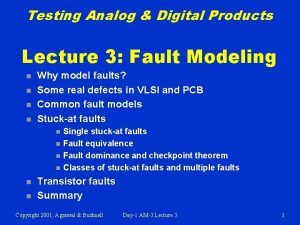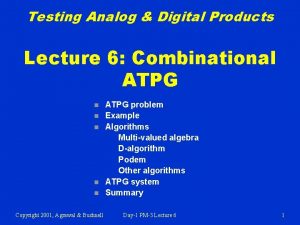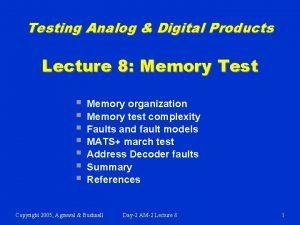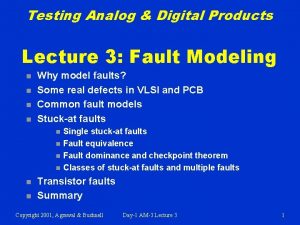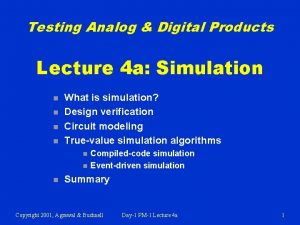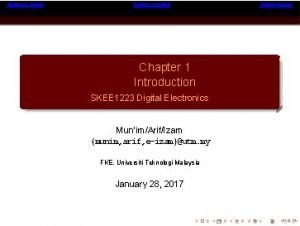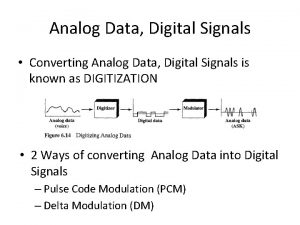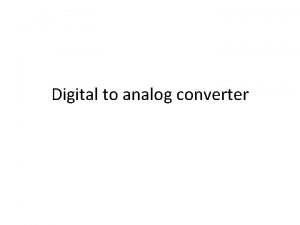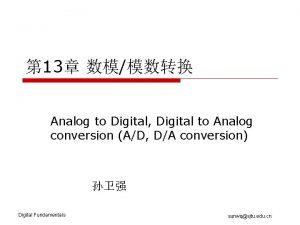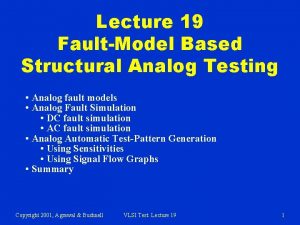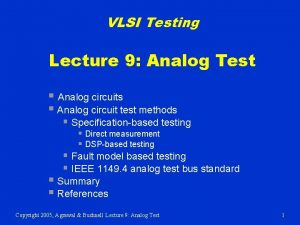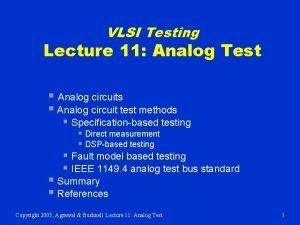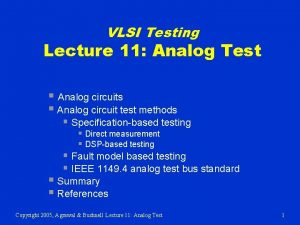Testing Analog Digital Products Lecture 12 System Diagnosis




















- Slides: 20

Testing Analog & Digital Products Lecture 12: System Diagnosis n n n Definition Functional test Diagnostic test § Fault dictionary § Diagnostic tree System design-for-testability (DFT) architecture § System partitioning § Core test-wrapper § DFT overhead Summary Copyright 2001, Agrawal & Bushnell Day-2 PM-3 Lecture 12 1

A System and Its Testing n n A system is an organization of components (hardware/software parts and subsystems) with capability to perform useful functions. Functional test verifies integrity of system: § § § n Checks for presence and sanity of subsystems Checks for system specifications Executes selected (critical) functions Diagnostic test isolates faulty part: § § § For field maintenance isolates lowest replaceable unit (LRU), e. g. , a board, disc drive, or I/O subsystem For shop repair isolates shop replaceable unit (SRU), e. g. , a faulty chip on a board Diagnostic resolution is the number of suspected faulty units identified by test; fewer suspects mean higher resolution Copyright 2001, Agrawal & Bushnell Day-2 PM-3 Lecture 12 2

System Test Applications Application Functional test Diagnostic test Resolution A Manufacturing Yes LRU, SRU Maintenance Yes Field repair LRU Shop repair SRU LRU: Lowest replaceable unit SRU: Shop replaceable unit Copyright 2001, Agrawal & Bushnell Day-2 PM-3 Lecture 12 3

Functional Test n n All or selected (critical) operations executed with non-exhaustive data. Tests are a subset of design verification tests (testbenches). Software test metrics used: statement, branch and path coverages; provide low (~70%) structural hardware fault coverage. Examples: § § Microprocessor test – all instructions with random data (David, 1998). Instruction-set fault model – wrong instruction is executed (Thatte and Abraham, IEEETC-1980). Copyright 2001, Agrawal & Bushnell Day-2 PM-3 Lecture 12 4

Gate-Level Diagnosis Karnaugh map Logic circuit (shaded squares are true outputs) b a d b c e T 2 a Stuck-at fault tests: T 1 = 010 T 2 = 011 T 3 = 100 T 4 = 110 Copyright 2001, Agrawal & Bushnell Day-2 PM-3 Lecture 12 T 1 T 4 T 3 c 5

Gate Replacement Fault Karnaugh map Faulty circuit (faulty output: red sqaure is 1 output) (OR replaced by AND) a b d b c e T 2 a Stuck-at fault tests: T 1 = 010 (pass) T 2 = 011 (fail) T 3 = 100 (pass) T 4 = 110 (fail) Copyright 2001, Agrawal & Bushnell Day-2 PM-3 Lecture 12 T 1 T 4 T 3 c 6

Bridging Faulty circuit Karnaugh map (OR bridge: a, c) a b c (red squares are faulty 1 outputs) b a+c d e a+c T 2 a Stuck-at fault tests: T 1 = 010 (pass) T 2 = 011 (pass) T 3 = 100 (fail) T 4 = 110 (pass) Copyright 2001, Agrawal & Bushnell Day-2 PM-3 Lecture 12 T 1 T 4 T 3 c 7

Fault Dictionary Fault Test syndrome t 1 t 2 t 3 t 4 No fault 0 0 a 0, b 0, d 0 0 1 a 1 1 0 0 0 b 1 0 0 1 0 c 0 0 1 0 0 c 1, d 1, e 1 1 0 e 0 0 1 Copyright 2001, Agrawal & Bushnell Day-2 PM-3 Lecture 12 a 0 : Line a stuckat-0 ti = 0, if Ti passes = 1, if Ti fails 8

Diagnosis with Dictionary look-up with minimum Hamming distance Fault OR AND OR-bridge (a, c) OR NOR Copyright 2001, Agrawal & Bushnell Test syndrome t 1 t 2 t 3 t 4 Diagnosis 0 1 e 0 0 0 1 0 b 1 1 1 Day-2 PM-3 Lecture 12 c 1, d 1, e 0 9

Diagnostic Tree T 3 T 2 Pass: t 4=0 a 1 T 3 a 1, c 1, d 1, e 1 T 4 Fail: t 4=1 c 0 T 1 T 2 a 0, b 0, d 0, e 0 Copyright 2001, Agrawal & Bushnell No fault found b 1 OR bridge (a, c) c 1, d 1, e 1 a 0, b 0, d 0 e 0 OR AND OR NOR Day-2 PM-3 Lecture 12 10

System Test: PCB vs. SOC PCB* n n n SOC** Tested parts In-circuit test (ICT) Easy test access Bulky Slow High assembly cost n n n High reliability Fast interconnects Low cost Untested cores No internal test access Mixed-signal devices * Printed circuit board ** System on a chip Copyright 2001, Agrawal & Bushnell Day-2 PM-3 Lecture 12 11

Core-Based Design n Cores are predesigned and verified but untested blocks: § Soft core (synthesizable RTL) § Firm core (gate-level netlist) § Hard core (non-modifiable layout, often called legacy core) Core is the intellectual property of vendor (internal details not available to user. ) Core-vendor supplied tests must be applied to embedded cores. Copyright 2001, Agrawal & Bushnell Day-2 PM-3 Lecture 12 12

Partitioning for Test n n n Partition according to test methodology: § Logic blocks § Memory blocks § Analog blocks Provide test access: § Boundary scan § Analog test bus Provide test-wrappers (also called collars) for cores. Copyright 2001, Agrawal & Bushnell Day-2 PM-3 Lecture 12 13

Test-Wrapper for a Core n n Test-wrapper (or collar) is the logic added around a core to provide test access to the embedded core. Test-wrapper provides: § For each core input terminal § § § A normal mode – Core terminal driven by host chip An external test mode – Wrapper element observes core input terminal for interconnect test An internal test mode – Wrapper element controls state of core input terminal for testing the logic inside core § For each core output terminal § § § A normal mode – Host chip driven by core terminal An external test mode – Host chip is driven by wrapper element for interconnect test An internal test mode – Wrapper element observes core outputs for core test Copyright 2001, Agrawal & Bushnell Day-2 PM-3 Lecture 12 14

A Test-Wrapper from/to External Test pins Scan chain to/from TAP Copyright 2001, Agrawal & Bushnell Day-2 PM-3 Lecture 12 Functional core outputs Core Scan chain Functional core inputs Wrapper elements Wrapper test controller 15

Overhead of Test Access n n Test access is non-intrusive. Hardware is added to each I/O signal of block to be tested. Test access interconnects are mostly local. Hardware overhead is proportional to: (Block area) Copyright 2001, Agrawal & Bushnell – 1/2 Day-2 PM-3 Lecture 12 16

Overhead Estimate Rent’s rule: For a logic block the number of gates G and the number of terminals t are related by t = K Ga where 1 ≤ K ≤ 5, and a ~ 0. 5. Assume that block area A is proportional to G, i. e. , t is proportional to A 0. 5. Since test logic is added to each terminal t, Test logic added to terminals Overhead = ------------------------- ~ A – 0. 5 A Copyright 2001, Agrawal & Bushnell Day-2 PM-3 Lecture 12 17

DFT Architecture for SOC Module N wrapper 1 Func. outputs Func. inputs Test Module wrapper Functional inputs User defined test access mechanism (TAM) Test source Test sink Functional outputs Instruction register control Copyright 2001, Agrawal & Bushnell Day-2 PM-3 Lecture 12 TDO TRST TMS TCK SOC inputs Test access port (TAP) TDI Serial instruction data SOC outputs 18

DFT Components n n Test source: Provides test vectors via on-chip LFSR, counter, ROM, or off-chip ATE. Test sink: Provides output verification using on-chip signature analyzer, or off-chip ATE. Test access mechanism (TAM): User-defined test data communication structure; carries test signals from source to module, and module to sink; tests module interconnects via test-wrappers; TAM may contain bus, boundary-scan and analog test bus components. Test controller: Boundary-scan test access port (TAP); receives control signals from outside; serially loads test instructions in test-wrappers. Copyright 2001, Agrawal & Bushnell Day-2 PM-3 Lecture 12 19

Summary n n n Functional test: verify system hardware, software, function and performance; pass/fail test with limited diagnosis; high (~100%) software coverage metrics; low (~70%) structural fault coverage. Diagnostic test: High structural coverage; high diagnostic resolution; procedures use fault dictionary or diagnostic tree. SOC design for testability: § § § Partition SOC into blocks of logic, memory and analog circuitry, often on architectural boundaries. Provide external or built-in tests for blocks. Provide test access via boundary scan and/or analog test bus. Develop interconnect tests and system functional tests. Develop diagnostic procedures. Copyright 2001, Agrawal & Bushnell Day-2 PM-3 Lecture 12 20
 Difference between digital and analog
Difference between digital and analog S domain
S domain Nursing diagnosis examples
Nursing diagnosis examples Medical diagnosis and nursing diagnosis difference
Medical diagnosis and nursing diagnosis difference Nursing diagnosis three parts
Nursing diagnosis three parts Nursing process and critical thinking
Nursing process and critical thinking Perbedaan diagnosis gizi dan diagnosis medis
Perbedaan diagnosis gizi dan diagnosis medis 01:640:244 lecture notes - lecture 15: plat, idah, farad
01:640:244 lecture notes - lecture 15: plat, idah, farad Compare and contrast analog and digital forecasts.
Compare and contrast analog and digital forecasts. Pengertian teknologi digital
Pengertian teknologi digital Analog vs digital
Analog vs digital Analog v digital
Analog v digital Modulation digital to analog
Modulation digital to analog Disadvantages of fsk
Disadvantages of fsk Introduction to digital video
Introduction to digital video Amw huebsch
Amw huebsch What us adc
What us adc Analog to digital converter
Analog to digital converter Analog to digital converter adalah
Analog to digital converter adalah Contoh soal data analog dan digital
Contoh soal data analog dan digital Rtv 332
Rtv 332











